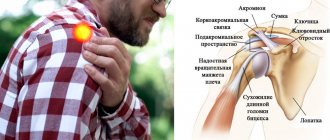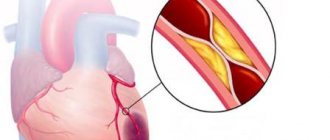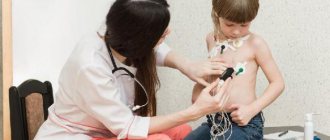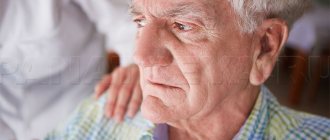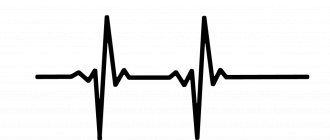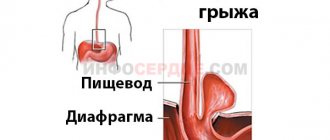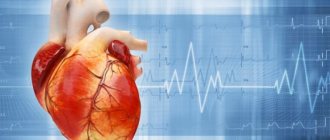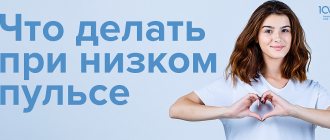Annual statistics clearly demonstrate that heart disease consistently holds a leading position in the list of the most common diseases in Russia. Out of 1000 people, such diagnoses are made to 26 patients.
The prevalence of these pathologies, according to experts, is caused by premature “aging” of heart muscle tissue. Late diagnosis also plays a role. Cardiologists warn: ignoring pain in the heart area is dangerous! If you are worried about pain in the heart area, do not wait until the situation worsens, consult a doctor immediately.
Acute pain in the heart is a symptom of a serious illness that can manifest itself completely unexpectedly and lead to irreparable consequences for the body. That is why it is very important to undergo timely and regular examinations. Now you have a unique opportunity to undergo a free consultation with a specialist and a set of preparatory examinations when enrolling in a course of enhanced external counterpulsation or shock wave therapy of the heart:
Promotion
Just until the end of autumn, undergo a free consultation and a set of preparatory examinations* when registering for a course of enhanced external counterpulsation or shock wave therapy of the heart.**
Send a request
* Check the details of the Promotion by phone. **Has contraindications; consultation with a doctor is required.
Enhanced external counterpulsation (EECP) Cardiac shock wave therapy (SWTS)
Hurry up to apply, the promotion period is limited.
How to recognize heart pain?
Sharp pain in the heart or pronounced discomfort in the chest area are manifestations of angina pectoris. However, not only heart pain manifests itself in this way; there may also be neurological disorders, malfunctions of the respiratory and digestive systems. To a layman, any pain in the chest seems to be a cardiac pathology, but they can be manifestations of osteochondrosis, neuralgia and even pulmonary diseases, such as pleurisy.
How to recognize that it is the heart that hurts? Unfortunately, it is impossible to independently diagnose cardiac pathology; this can only be done by specialists using modern diagnostic equipment. However, it is important to know the main symptoms of heart disease. If you find any of them in yourself, immediately contact a cardiologist:
- the pain does not stop for an hour or more;
- pain occurs even during a night's rest with complete physical rest;
- pain intensity decreases after taking nitroglycerin;
- painful spasms are accompanied by a feeling of suffocation, dizziness, and fainting conditions;
- chest pain begins after intense physical or psychological stress;
- the heartbeat noticeably increases, disruptions in the functioning of the heart are felt;
- the skin acquires an unhealthy pale tint;
- physical weakness and malaise are felt, sweating appears.
When to call an ambulance?
When there is no confidence in the correctness of the measures taken, you should not overestimate your knowledge; it is better to call an ambulance.
A special attitude has been formed towards people in a drunken state. They are not trusted even when complaining of severe heart pain. Do not leave such a person alone, although he may be very unpleasant. Call an ambulance and make sure the car has arrived.
If, despite help, it hurts severely for 15-20 minutes, rhythm disturbances or dizziness appear, you need to call an ambulance. Prolonged pain cannot be tolerated. The ambulance has ECG machines. It is possible to conduct an initial diagnosis to exclude acute infarction. The equipment includes painkillers.
The correct course of action: after the assistance provided, the patient felt improvement, but it is still necessary to undergo a full examination at the clinic, without waiting for repeated attacks. There is no need to joke with your heart.
Stitching heart pains
A sudden, sharp stabbing pain in the heart is one of the most striking signs of a heart attack, which often leads to a heart attack. You should urgently call an ambulance if the pain radiates to the left arm, neck, lower jaw and back. However, pain has the same character when:
- pericarditis or inflammation of the heart membrane;
- cardiomyopathy;
- neurosis, the localization of which is near the heart;
- coronary spasm, characterized by impaired circulation of the heart vessels.
Diagnostics
The initial appointment with a cardiologist begins with a medical history, external examination and physical examination of the cardiovascular system. When auscultating the heart, muffled tones, functional or organic murmurs are heard. Blood pressure is measured in the arms and legs, and ABPM is prescribed if necessary. To establish the etiology of pain in the heart, a number of laboratory and instrumental techniques are used:
- ECG.
The cardiogram often reveals signs of left ventricular hypertrophy, rhythm and conduction disturbances, and symptoms of cardiac muscle ischemia. ST segment elevation in combination with T wave inversion is pathognomonic for MI. To clarify the diagnosis, functional stress tests with physical activity are performed. - EchoCG.
According to ultrasound data, the anatomical structure of the heart, the functioning of the valves, and the thickness of the myocardium are assessed. Echocardiography measures left ventricular ejection fraction. Doppler sonography is performed to study blood flow in the coronary arteries and great vessels. - X-ray methods.
Plain radiography of the chest cavity is recommended for visualizing the size and contours of the heart and calculating the cardiothoracic index. A cardiac CT scan is required for a detailed examination of the coronary arteries, pulmonary vessels and cardiac cavities. - Coronary angiography.
An invasive technique is indicated for the probable development of myocardial infarction and coronary artery stenosis. A contrast agent is injected into the vascular bed, which allows visualization of the inner surface of the arteries of the heart, identifying blood clots and atherosclerotic plaques. - Laboratory methods.
An increase in cholesterol and LDL in a biochemical blood test indicates atherosclerosis. To confirm MI during an anginal attack, the level of myoglobin, troponin, and cardiac enzymes is determined. To exclude rheumatism, acute phase indicators and antistreptolysin-O are measured.
Given the high prevalence of noncardiac causes of heart pain, consultation with other specialists is usually necessary. For possible GERD, EGD and pH testing are prescribed. To assess the condition of the ribs and thoracic spine, radiography in two projections, CT, and MRI are performed. If cardiac neurosis is suspected, tests are performed to assess the functional state of the autonomic nervous system.
Pressing heart pain
Basically, sensations of this nature indicate the presence of angina. Such pain can radiate to the chin, lower jaw, and shoulder. In this case, there is numbness in the left arm from the shoulder joint to the fingers. The duration of an attack can vary from one hour to several days. Pain occurs both as a result of exertion and in a calm state. Often, patients complain that their heart hurts at night, noting the pressing nature of the pain.
However, a heart attack can be accurately diagnosed only through examination, since myocarditis and mitral valve prolapse, as well as intercostal neuralgia, also manifest themselves.
Necessary examinations
When I encounter such phenomena, I immediately refer the patient for an ECG. This is especially true for people over 45 years of age, even if the signs are not typical for myocardial ischemia. It is better to make sure that the person is not in danger, and only then calmly carry out treatment for neurological or other abnormalities. If you have angina, you should do an ECG with stress, since it may not show any changes when pain is eliminated.
In some cases, it is necessary to use other instrumental methods:
- Coronary angiography. It is carried out using contrast injection and helps determine the presence of narrowing in the vessels of the heart.
- EchoCG. Ultrasound is used for this. It allows you to see the structure of the chambers of the heart muscle, the condition of the valves, the thickness of the walls, and the presence of inflammatory processes.
- Tomography of the spinal column (or MRI). Performed after ruling out cardiac pathology. During the manipulation, the size of the intervertebral spaces and the condition of the bone tissue, the presence of disc protrusions and pinched neurovascular roots are assessed.
The laboratory evaluates biochemical markers (ALT and AST), their increase indicates the development of a heart attack or myocarditis. More modern ways to determine acute necrosis are to increase the concentration of troponins in the blood.
Dull heartache
Dull pain in the heart area is not only a sign of cardiac pathology. This symptom may indicate problems with the spine and lungs. Its reasons may be:
- manifestations of mitral valve disease;
- some forms of myocarditis;
- symptoms of neurocirculatory dystonia.
Unlike other causes, dull heart pain has one distinctive feature - it is long-lasting and regular.
An attack can be triggered by active work, a stressful situation, hypothermia or overeating.
Myocardial infarction
If an attack of angina pectoris lasts a long time, then the heart muscle, not receiving nutrients and oxygen, begins to quickly deteriorate, its necrosis (death) occurs, this is myocardial infarction. That is why you should never tolerate pain due to angina pectoris.
Myocardial infarction is manifested by attacks of severe pain in the chest, which are not relieved by nitroglycerin. The duration of this pain is from 20-30 minutes to several hours. In such cases, the sooner the patient receives medical assistance, the greater the chance of recovery.
Pain in the heart area: causes
Heart pain has many causes, the main ones being:
- necrosis of myocardial cells or infarction, pain can be of a different nature;
- an inflammatory process caused by infection, or myocarditis, characterized by aching, pressing, dull pain;
- ischemia and angina pectoris, causing aching, squeezing, pressing pain;
- inflammatory processes in the heart sac, which determine the nature of the pain, such as aching, dull, cutting, pain also occurs on inspiration;
- mitral valve prolapse with aching, pressing pain;
- high blood pressure, giving a feeling of heaviness in the chest;
- hypertrophic processes in the heart muscle with stabbing, aching, pulling, sharp manifestations of pain during exercise;
- myocardial dystrophy, causing aching, sharp, pressing pain.
Prevention
Preventing a disease is always better than treating it. Therefore, even at a young age, you should think about the state of the cardiovascular system (Fig. 7). It is especially important for people at risk to follow all measures to prevent heart disease:
- to refuse from bad habits,
- control weight (body mass index should be less than 25),
- follow the principles of proper nutrition,
- avoid excess salt in dishes,
- exercise,
- avoid stressful situations and learn to react correctly to them,
- control blood pressure.
It is also important to promptly treat diseases of other organs. Hormonal diseases, inflammatory processes and other pathologies can cause heart complications.
Figure 7. Principles of prevention of cardiovascular diseases Source: MedPortal
How to help yourself with heart pain?
During an attack of heart pain, the main thing is not to panic and try to calm down. It is best to take a horizontal position or sit comfortably, leaning on a support. It is worth removing or loosening anything that may make breathing difficult: collar, tie, belt. Be sure to take 1 tablet of nitroglycerin under the tongue. After 15 minutes the pain should subside. If nitroglycerin does not help, do not hesitate, urgently call an ambulance; the patient may have developed a myocardial infarction.
If pain in the heart appears for the first time, do not rush to make a diagnosis yourself; it may not be a manifestation of cardiac pathology at all. It is necessary to take Corvalol or Validol in a dosage of 40 drops and take the most comfortable position, limiting movements and relaxing.
Treatment
Help before diagnosis
Most cases of heart pain occur during emotional and physical stress, so a person needs to sit or lie down and try to calm down. It is necessary to unfasten the collar, remove tight clothing, and provide access to fresh air. In case of interruptions in the functioning of the heart, it is advisable to take a deep breath and strain, pressing your fingers on the closed eyeballs. To relieve anginal pain, nitrovasodilators are used.
Conservative therapy
After verification of the main diagnosis, complex etiopathogenetic treatment is carried out. If problems with the digestive organs are identified, the patient is referred to a gastroenterologist. A neurologist and vertebrologist are involved in the treatment of osteochondrosis. For pain in the heart associated with cardiovascular pathology, the following are prescribed:
- Antihypertensive drugs
. The drugs reduce pre- and afterload on the heart, due to which the myocardium begins to contract normally. This helps eliminate painful sensations, and also sharply reduces the likelihood of hypertensive crises, heart attacks and strokes in hypertensive patients. - Antiarrhythmic drugs
. Medicines stabilize the frequency and rhythm of heart contractions, coordinate the contractility of the atria and ventricles. After the heart rhythm is restored, pain and discomfort disappear, and overall health improves. - Antianginal agents
. Medicines are recommended for ischemic heart disease. They improve blood supply and trophism of the heart muscle, reduce preload. At the same time, reversible damage to myocardial fibers is restored, and typical pain attacks are reduced. - Thrombolytics
. The drugs are administered in the first hours after the diagnosis of myocardial infarction. They destroy blood clots in the coronary artery and restore normal blood flow. With their early use, it is possible to limit the necrosis zone as much as possible. - Anti-inflammatory drugs
. Medicines from the NSAID group are used for inflammation. The drugs reduce the production of cytokines that cause heart pain. For rheumatic lesions, glucocorticosteroids must be prescribed.
Treatment of cardioneurosis begins with the selection of non-drug methods. Patients are advised to normalize their daily routine, increase sleep and rest time, and avoid stressful situations if possible. For serious psycho-emotional problems, individual and group psychotherapy is effective. To normalize the functioning of the central nervous system, take herbal sedatives.
Surgery
The intervention of cardiac surgeons is required when conservative therapy for myocardial infarction is ineffective or impossible. To restore coronary blood flow, transluminal balloon angioplasty (TLBAP), percutaneous angioplasty with the installation of a stent at the site of arterial stenosis, is used. Coronary artery bypass grafting (CABG) is less commonly performed.
Surgical treatment is necessary for severe arrhythmias. In most situations, they resort to the implantation of a pacemaker, which maintains the correct rhythm of the heart. For malignant tachyarrhythmias, installation of a defibrillator is indicated. To eliminate atrial fibrillation and extrasystoles, radiofrequency ablation is used.
Instrumental studies
In addition to an electrocardiogram (ECG), in case of cardiac pathology, various instrumental diagnostic studies .
- Ultrasound of the abdominal cavity;
- FEGDS examination of the digestive organs;
- Ultrasound of the heart, pulmonary vessels and aorta;
- FVD, examination of external respiration functions;
- Chest X-ray;
- CT, computed tomography;
- MRI, magnetic resonance imaging;
- EchoCG, echocardiography and others.
Expert advice
For all people who want to eliminate diseases that cause heart pain from their lives in the future, I would like to recommend the following:
- do not wait for unpleasant symptoms and reconsider your lifestyle today;
- choose the right diet and eat small portions and often;
- drink enough water (1.5-2.5 l);
- eliminate all bad habits;
- exercise, swimming, running;
- listen carefully to the signals of your body and if even minor problems appear, immediately go to an appointment, undergo examinations and then follow the doctor’s recommendations.

